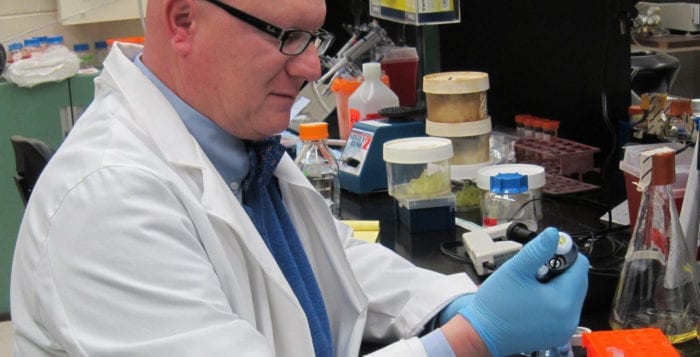Maurizio Del Poeta, a professor in the Department of Molecular Genetics & Microbiology at Renaissance School of Medicine at Stony Brook University, works to combat potentially deadly fungal infections. Recently, several press reports have highlighted the prevalence in New York and New Jersey of Candida auris, which is resistant to drugs and can cause death. Through an email exchange, Del Poeta shared his perspective on this fungal infection and his efforts to develop a treatment.
Are there multiple drug-resistant strains of numerous types of Candida?
Yes, there are several species of Candida that are resistant to some antifungals. For instance, Candida lusitaniae is normally resistant to amphotericin B. Candida glabrata is normally resistant to fluconazole. There are over 20 species of Candida that can cause infection in humans. Most are sensitive to antifungals. C. auris is normally resistant to all antifungals. They are resistant for mainly two reasons: (1) the target/enzyme is genetically different and, thus, the drug does not recognize the target; thus it does not bind to the target; and thus it does not inhibit it; (2) the drug is pumped out by membrane transporters. C. auris is notorious for having multiple membrane transporters.
I understand the damage from Candida is primarily among people who are immunocompromised. Is there a risk for those people who are also healthy?
Healthy people should be fine. But who is really “healthy?” Because C. auris is spreading in hospitals and nursing homes, all patients in hospitals and nursing homes are at risk: some more (e.g., cancer patients, patients with an organ transplant, patients in ICU, patients taking corticosteroids) and some patients have less risk because they are more immunocompetent, but certainly those patients could get contaminated.
What makes it so hard to eliminate Candida?
Because (1) we are not used to and (2) because we still do not know which type of disinfectant is efficacious against C. auris … Unlike other Candida infections, which are generally thought to result from autoinfection from host flora, C. auris can be transmitted between patients … C. auris requires implementation of specific infection control measures, such as those used for control of [other infections] (e.g., private room and on contact precautions). Because C. auris can survive in plastic surfaces, floors, and door knobs for weeks, it is essential that infection control measurements be implemented in the health care settings.
Does the work you’re doing offer hope, albeit in the earlier stages, for ways to treat and reduce the virulence of Candida?
Yes, our new compounds are sensitive to C. auris in vitro against the C. auris clinical isolates that are resistant to current antifungals. We are currently testing their efficacy in vivo (animals). We are doing this in collaboration with the National Institutes of Health and the Health Science Center in San Antonio, Texas. Our compounds have different mechanism of action from the current antifungals,
Given that the symptoms of a Candida infection -— fever, weakness and aches — are so prevalent in other types of infections, are there ways to make a clinically differentiated diagnosis of Candida without taking a blood sample or conducting extensive analysis?
Unfortunately, there are not. Diagnosis of C. auris can only be made using sophisticated tests. Normal phenotypic tests are not able to identify C. auris for certain. If we want to stop (or at least control) the epidemic, anyone with a Candida infection in a hospital setting should be treated as C. auris. Hospital trafficking of nurses, doctors, visitors from and to patients with C. auris should be highly restricted. Nurses and doctors should not be allowed in cafeteria without changing gowns, particularly if they are taking care of a patient infected with C. auris and other common sense practices should be implemented; but, unfortunately, they are normally out of the window in the hospital settings … In the case of C. auris “isolating rooms” and “contact precautions” should be implemented.
How does your treatment for Candida work?
The class of compounds are “acylhydrazones.” They target the synthesis of fungal sphingolipids.
Given what you know about the prevalence of Candida, particularly in New York, and the minimal information about the specific locations where hospitals have found Candida, what would you advise anyone who might be “at risk” for Candida to do if they had elective surgery scheduled?
Elderly and immunocompromised people going to the hospital should be treated with “contact precautions.” No need for isolation unless positive for C. auris.
Is C. auris the most virulent or problematic species of Candida confronting public health professionals today?
Not really. C. glabrata is also a nasty Candida strain. What makes C. auris difficult is the resistance to drugs.
Do other species suffer through Candida infections as well?
Although humans are the most known carriers and hosts for Candida infection, other animals can also get infected such as dogs, horses and cattle. Certain Candida species are used in food production. Candida utilis extracts are used in Asia as a “salt” instead of salt because these extracts are salty and do not cause hypertension. We actually have a collaboration with the Japanese company that makes these extracts. Candida krusei is used to ferment cacao during chocolate production. Whereas C. utilis is not a human pathogen, C. krusei actually is.
How do you protect yourself, your office and your staff from the spread of the infection?
We use biosafety label 2. My lab is certified to handle BSL2 organisms, such as C. auris. We use all sorts of protective gears and standard protective procedures to make sure lab personnel are protected and to make sure we keep the microbes inside the lab. Entrance to my lab is strictly prohibited to anyone that did not receive appropriate training.





